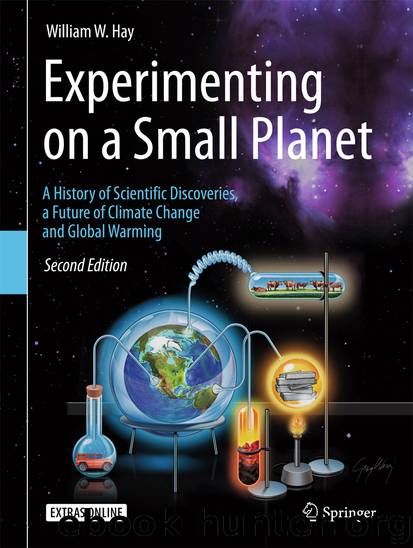Experimenting on a Small Planet by William W. Hay

Author:William W. Hay
Language: eng
Format: epub
Publisher: Springer International Publishing, Cham
If you look up molecular motions in a book on physics or mechanics, you will immediately be confronted with two special terms: ‘degrees of freedom’ and ‘degenerate.’ In physics, a degree of freedom of a system is a parameter that contributes to the state of a physical system. That can cover a multitude of sins, so to speak. In the case of the molecules listed above, the body can move independently in the three directions of space (remember the Cartesian coordinate system?). The momentum of a body consists of three components; each called a degree of freedom. A molecule with x atoms has 3x − 6 normal modes of vibration, but a linear molecule, with the atoms in a straight line, has only 3x − 5 because rotation about the linear axis doesn’t count as vibration. For diatomic molecules like N2 and O2: (3 × 2) − 5 = 1. ‘Degenerate’ means that although there might be two modes, as shown for rotation of N2 in Fig. 16.2, you cannot distinguish between them because they depend on how you view the object. The two modes of rotation shown above are degenerate because if you observed D from the plane of this page, it would look like C. Your perception of things depends on your point of view.
There is another important thing about these particles that make up most of the air. They have no electrical polarity. Their electrical charge is neutral; they have the same number of protons and electrons, and the electrons are evenly distributed.
In addition to these gases, the atmosphere contains variable amounts of trace gases that readily interact with photons in the thermal infrared range. To do this the molecule must be ‘dipolar,’ that is it must have some degree of electrical charge, positive on one side, negative on the other. The concentrations of the gases are expressed in terms of parts per million by volume. Avogadro’s Law states that, at a given temperature and pressure, equal volumes of gases contain equal numbers of molecules. The most variable and potentially most abundant trace gas is water vapor (∼0–40000 ppmv = 0–4 %, depending on temperature and availability). The other major trace gases are carbon dioxide (CO2, 278 ppmv in 1750, 394 ppmv in 2011 = 0.0278 and 0.0394 % respectively), methane (CH4, 0.700 ppmv in 1750, 1.808 ppmv in 2011), and nitrous oxide (N2O, 0.270 ppmv in 1750, 0.323 ppmv in 2007). These are the major greenhouse gases affecting the temperature of Earth’s surface. Schematic models of them are shown in Fig. 16.4.
Fig. 16.4The four major greenhouse gases that interact with infrared radiation. a Water. b Carbon dioxide. c Nitrous oxide. d Methane
Download
This site does not store any files on its server. We only index and link to content provided by other sites. Please contact the content providers to delete copyright contents if any and email us, we'll remove relevant links or contents immediately.
Man-made Catastrophes and Risk Information Concealment by Dmitry Chernov & Didier Sornette(5649)
The Revenge of Geography: What the Map Tells Us About Coming Conflicts and the Battle Against Fate by Kaplan Robert D(3961)
Zero Waste Home by Bea Johnson(3655)
In a Sunburned Country by Bill Bryson(3367)
COSMOS by Carl Sagan(3347)
Good by S. Walden(3346)
The Fate of Rome: Climate, Disease, and the End of an Empire (The Princeton History of the Ancient World) by Kyle Harper(2872)
Camino Island by John Grisham(2719)
A Wilder Time by William E. Glassley(2690)
Organic Mushroom Farming and Mycoremediation by Tradd Cotter(2565)
The Ogre by Doug Scott(2501)
Human Dynamics Research in Smart and Connected Communities by Shih-Lung Shaw & Daniel Sui(2431)
Energy Myths and Realities by Vaclav Smil(2380)
The Traveler's Gift by Andy Andrews(2299)
9781803241661-PYTHON FOR ARCGIS PRO by Unknown(2268)
Inside the Middle East by Avi Melamed(2230)
Birds of New Guinea by Pratt Thane K.; Beehler Bruce M.; Anderton John C(2175)
A History of Warfare by John Keegan(2104)
Ultimate Navigation Manual by Lyle Brotherton(2048)
